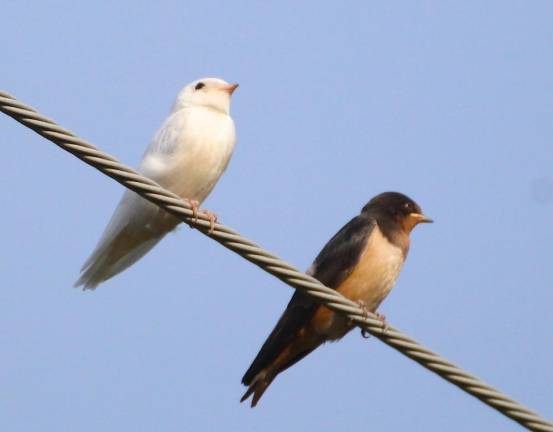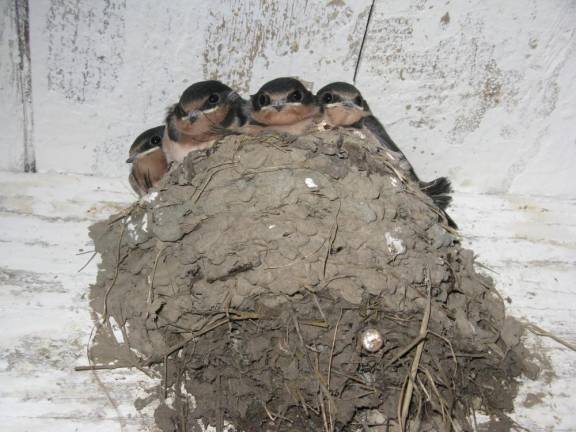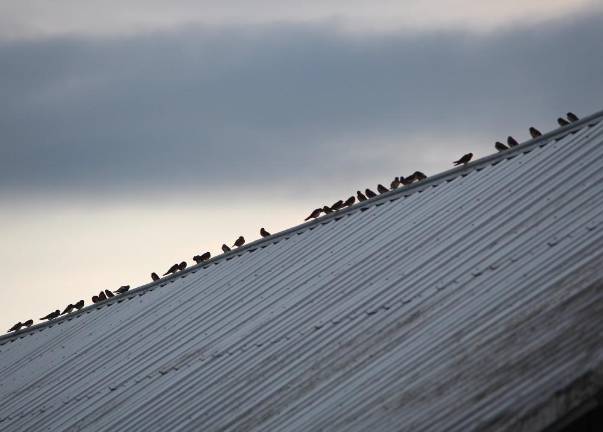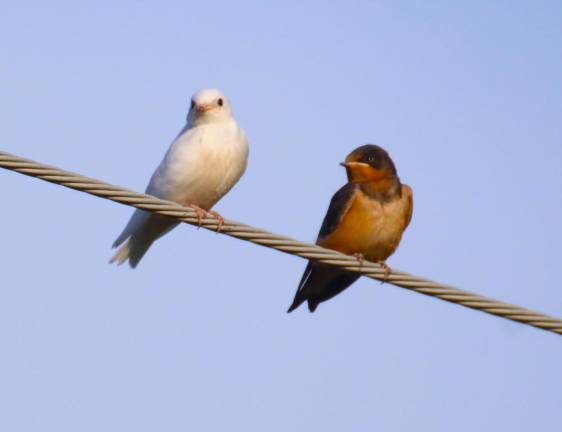Swallow of a different color
A once-in-a-lifetime visitor made its first home in the dairy barn




I wouldn’t exactly call myself a birdwatcher, but I do like birds. I’m especially fond of chickadees, mourning doves, cardinals, herons (both blue and green) and the big raptors that glide so easily overhead. Barn swallows, though, are my favorites and the birds I know best. They are small, graceful in flight, and they travel so far.
Our farm has an old dairy barn. For the 35 years of our tenure, and likely before, each spring three or four pairs of barn swallows have arrived from the south and taken up residence in the lower barn where cows once were milked. Only one year were they absent. It was because the sliding door at the back of the barn was closed and the removable sash windows that keep out the winter snow were still in place. That year the swallows were not with us. I never again forgot to remove the windows at the first sign of spring.
As soon as they arrive, the swallows either select nests still attached to the barn rafters from previous years or build new ones with mud pellets, feathers and bits of dry grass. It takes a week or more and maybe a thousand trips back and forth, with mud in their beaks, for a pair of swallows to fashion a new nest. The female then typically lays four or five eggs, which she and her partner take turns incubating for approximately two weeks. The hatchlings remain in the nest, not able to fly, for another three weeks during which both parents diligently bring them small insects snatched out of the air. A pair of swallows can raise two and sometimes even three sets of young in the few months they are with us.
Most years all the swallows leave the farm together. For a week or so before leaving they periodically assemble on the barn roof or on a telephone line leading to the house. I once counted more than 40 on the barn roof at one time. Then, within a day or two, they were gone.
In the middle of last August, a week or so before the birds’ collective departure, I saw something I’ve never seen before: a perfectly white swallow perched on the telephone line. Very close to it was a regular swallow, with dark blue head and back feathers and rusty colored underparts. I guessed it to be a parent of the white bird. The two stayed together for almost an hour, which is unusual. Unless sitting on eggs, swallows don’t generally stay in one place longer than a few minutes. The two birds were frequently visited by numerous other swallows, some of whom alighted on the telephone wire alongside them, but the visits were brief. It seemed to me that they were checking in on the white swallow, perhaps offering encouragement or tips on getting airborne. Or maybe they were simply curious.
According to my research, whiteness or albinism in swallows does occur, but very rarely. It’s unlikely that any of the normally colored swallows had encountered a white bird of their kind before. (Sad to say, my research also informed me that if the white swallow is a true albino, it is probably not destined to live a long life. Lacking protective pigments in its eyes, it will soon become visually impaired or blind.)
There was plenty of time for me to fetch my camera and tripod. I took photos but mostly just sat and watched the novel scene above me. I’m pretty sure the white swallow was a recent fledgling. Otherwise, I would have seen it, either in the barn or flying around outside. It certainly stood out. Always interested in what the barn swallows are up to, I have watched swallow parents teaching or encouraging their young to fly. It’s easy to see what’s going on when the babies are perched hesitantly on a barn windowsill and one or both parents are hovering in the air just a few feet away.
This swallow was outside the barn but still close to it. My assumption was that it must have taken a first short flight but was still nervous or uncertain. Having spent its early life in the dimly lit barn, the outside world, with big trees, green fields and vast blue sky, may have been a lot to take in and a bit intimidating.
Finally, the white swallow took flight. The presumptive parent immediately joined it. What happened next was quite remarkable. Within mere seconds, the many other visiting swallows reappeared. Together, they began to dive and turn and rise and dive again in what appeared to be a wild celebratory aerial dance, a welcoming of a new member, even of such a different hue, to the community of swallows.
The following day I saw the white swallow once more, flying with the others and stopping periodically for a break on the telephone line. A few days later they all left, probably on their way to Capistrano. No, that’s my imagination running wild. The celebrated birds that return to San Juan Capistrano are actually cliff swallows, a slightly different species, and they are returning from Argentina to spend the Northern hemisphere summer in California. Our flight of swallows, with their new white addition, were more likely headed for warmer weather in Central or even South America. Not bad for a bird that weighs less than an ounce.